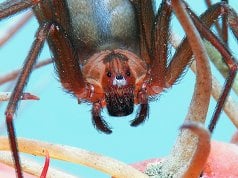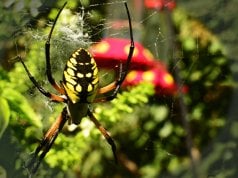Ladybugs are a large group of insects in the Coccinellidae taxonomic family. They are small beetles, and depending on the region the ladybug is also referred to as “ladybirds,” “lady beetles,” or “ladybird beetles.”
There are a huge variety of species in the Coccinellidae family, possibly 5,000 or more! The vast majority of species feed on pest species, making them beneficial for farmers. Read on to learn about the ladybug.
Description of the Ladybug
The most famous coloration of these insects is red with black dots, but they come in a variety of colors and patterns. These beetles can be red, orange, brown, or yellow and can have spots, stripes, or other patterns. Most species are round or rounded, and have a dome-shaped body with protective coverings over their wings. The patterns usually occur on the wing covers of the insect.
Interesting Facts About the Ladybug
With thousands of different species to choose from, you will never find a shortage of information on ladybugs! These little beetles come in so many different colors and patterns, and each has it’s own behavioral patterns as well.
- Beetles vs. Bugs – Ladybugs are not considered “true bugs.” They are members of the taxonomic class Insecta, but they are more closely related to beetles than “bugs.” Where bugs have needle-like mouths, beetles are equipped with mouthparts more adapted to chewing.
- Garden Guardian – While this is not the case with all species, the vast majority feed on small pesky bugs that feed on crops and other plants. Their favorite food, aphids, can be destructive to farms and gardens. A single ladybird can consume as many as 5,000 aphids in a lifetime!
- Warning Signs – The conspicuous coloration on these insects is not just for aesthetic purposes, it is a sign to potential predators that they aren’t a yummy snack. The joints in their legs ooze a bitter substance when the insect is threatened, and it does not taste very appetizing to predators. This foul taste release is known as reflex bleeding.
- Virgin Bug – The name “ladybug” does not mean all of them are females, instead it actually refers to the Virgin Mary. During the middle ages, destructive swarms of aphids were feeding on crops. The desperate townspeople prayed to the Virgin Mary for help, and groups of ladybugs began eating the pesky aphids. The farmers dubbed the insects “Our Lady’s Beetles.”
Habitat of the Ladybug
These little insects can be found in a number of different types of habitats. The environment choice is usually a reflection of the location of their favorite prey, depending on the species. They can be found in grasslands, meadows, urban parks and gardens, forests, wetlands, and more. They will hide from predators in shrubs, grasses, trees, and more.
Distribution of the Ladybug
With so many different species, it is no wonder that these insects can be found nearly worldwide. Unlike other cosmopolitan (widespread) creatures, ladybugs are found more frequently in warmer climates. There are over 400 different species in North America, and 175 species found in California alone.
Diet of the Ladybug
Some species feed on plants, but for the most part these creatures are insectivores. They feed on other, smaller insects, commonly those that are considered pest species to farmers.
Some common prey includes aphids, scale insects, spider mites, caterpillars, insect larvae, insect eggs, and other beetles. They have also been known to feed on honeydew, other fruits, berries, nectar, fungi, sap, and pollen.
Ladybug and Human Interaction
For the most part, these creatures are beneficial to humans. Some will even introduce species that are known to prey on agricultural pests in an effort to safely reduce pest populations. Unfortunately, some species are threatened by environmental and climate change.
Some species that are introduced to reduce pests can actually become a pest themselves, as they outcompete native species. The interaction with humans is typically dependent on the specific species and its history.
Domestication
While these insects have been used for agricultural purposes, they have not been selectively bred for any specific traits. This means they cannot be considered domesticated.
Does the Ladybug Make a Good Pet
If they are provided with the proper food and care, ladybugs can make good hands-off or minimal handling pets. You should always make sure that you never release any pet into the wild.
Ladybug Care
These creatures will have different needs depending on the species. For insectivorous species ensure you provide appropriate prey, aphids work well for many species but some commonly available prey, like crickets, may be too large.
Do not provide too large of an enclosure, so food can be easily located and eaten. Ensure the enclosure has plenty of ventilation, but not so large that the beetles can escape. It is also important to provide a water source that they cannot drown in, like a damp sponge or water gel.
Behavior of the Ladybug
Each species of ladybird is different. Some are solitary and only interact with others of their species during breeding, some are partly solitary and congregate in large numbers during the winter or while migrating, and others are social year-round. Most species are diurnal, which means that they are active during the day.
Reproduction of the Ladybug
All species have different reproductive strategies, and each has its own specific pheromone to attract a mate. The female will store the sperm from mating for up to three months before fertilizing her eggs. This allows her to choose a time when the young are most likely to survive, usually when prey is most plentiful. Each species lays different numbers of eggs, but most are deposited on the underside of vegetation.














![Red Angus Closeup of a beautiful Red Angus cowPhoto by: U.S. Department of Agriculture [pubic domain]https://creativecommons.org/licenses/by/2.0/](https://animals.net/wp-content/uploads/2020/03/Red-Angus-4-100x75.jpg)

